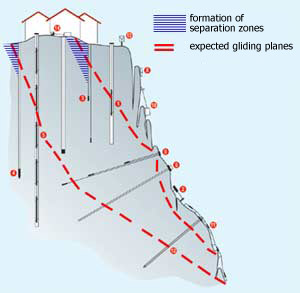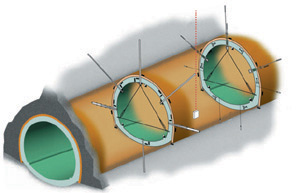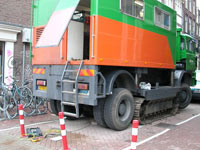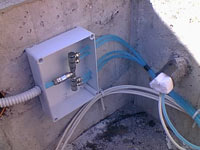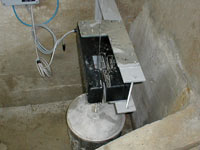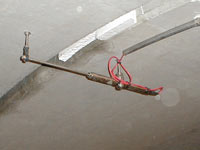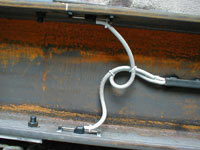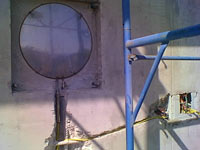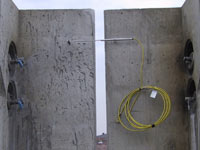Monitoring Equipment. Monitoring (Case Studies)
Equipment for monitoring of
- High structures, housing estates, subway tunnels and overpasses, bridges, dams of hydroelectric power stations and tidal power stations, other complex engineering structures
Output production (devices and equipment) for specialized geotechnical monitoring, depending on controlled parameters, can be conditionally divided into several groups:
Inclinometers and Tiltmeters - in-place, surface, with digital indication
- inclinometers with servo probe (vertical and horizontal model);
-
tele-coordinometer (TEL-310);
-
multi-function datalogger (NADIR) for inclinometer measurements (with data processing software package);
-
portable tiltmeter (TILLI): measurements are conducted at the special tilt plate permanently installed on either horizontal or vertical surface;
-
pendulum systems for monitoring horizontal movements in concrete dams and dam foundation, determining the vertical deviation of high buildings and structures, elevator shafts.
|
|
|
|
Extensometers (displacement gauges, dimensional change gauges, settlement transducers) - single and multipoint (with enlarged measuring rod).
|
|
embankment extensometers (monitoring of lateral strains) and fixed
extensometers (monitoring of embankment settlement or heave);
tape extensometers - for convergence monitoring of tunnel
linings and for distance measurements in excavation and mining
openings;
borehole, magnetic, three-component extensometers - a basis for
monitoring of the mining area surrounding the engineering structure;
settlement gauges, DSM-system (differential settlement monitoring
system) for long-term tracking of behavior of structures.
|
|
|
|
|
Crackmeters and Jointmeters - uniaxial and 3-D (triaxial)
|
|
terminal displacement transducers (for remote readout);
integrated systems (GRID) - 4 miniature electrical fissure
meters with a compact datalogger;
wire crackmeters - for detecting movements (expansion and
contractions) in rock masses. Distance between the anchors can be up to 30
meters with an opening (convergence) range of 2 meters.
|
|
|
|
|
Load Cells
Earth Pressure Cells - (have a stainless steel 230 mm diaphragm when used for measurements of soil pressure in earth fill embankments; a rectangular plate 100 x 200 mm is used for measurements in hard material.); a flat support allows to determine the elasticity coefficient and deformation capabilities of rock, concrete and brickwork.
Concrete Stress Cells are used for tunnel monitoring within concrete linings. Suitable for radial measurements (up to 20 MPa). Measuring cells have a complementary repressurizing device (to ensure an intimate contact between the pad and the concrete after installation).
Strain Gauges are used for measuring strains both in steel and concrete structures; available in different models suitable for various applications:
a) with electrical strain-gauge with ceramic diaphragm,
b) vibrating wire strain-gauge.
Mostly these gauges are installed on the reinforcement before concrete grouting at production of complicated building units, load-bearing elements (piles, joistings, bridge trusses or spans), etc. Such approach allows to control behavior of structure's load-bearing elements under load.
Hydraulic Anchor Load Cells - anchor load cells (electrical/hydraulic or strain-gauge load cells with capacity from 3,000 kN up to 10,000 kN) allow to monitor struts, concrete tiebacks, anchor supports and steel tiebacks, load on bridge pillars, overbridges and aqueducts. Can be used as an overload indicator in cathead pillars at production sites.
|
|
|
|
|
|
|
|
Hydrological (Engineering-geological) Monitoring
|
|
|
|
|
|
|
|
|
|
|
Readout Units, Data Recorders and Data Loggers - from elementary digital readout devices and handy indicators with LCD to multi-function portable data loggers.
- Minilogger - a remote stand-alone data logger; total memory capacity of 64,000 data, RS 485 communication port.
-
Datalogger (ADK-10) - a powerful and versatile multi-function data logger built around the CR10X module. It is a microcomputer, clock (timer), multimeter, calibrator, scanner, frequency counter and controller. A multitasking operating system allows simultaneous communication and measurements functions. The basic module allows to scan up to 6 multiplexers. Multiplexers provide additional inputs up to 192 analog or differential (digital) channels.
-
Software program (Multilogger) - is designed for real-time monitoring (on the basis of ADK-10 datalogger). Option selection includes multiplexer scan, channel configuration, scan interval, alarm limit entry with warning signal out, graphs representation, local and remote communication by RS232 COM port, MD-9 direct connection, phone modem or GSM.
|
|
|
|
|
|
|
|
Objects Monitoring (case studies)
The most complex and multi-component control systems are designed to monitor high structures, subway tunnels that are driven in unstable rocks (floating earth, zones of fissuring, high probability of formation of subsidence craters, etc.), dams, landslides, complex engineering structures.
Each of the listed objects is unique not only because of its constructive characteristics but in connection with uniqueness of mining and geological conditions in which it is constructed. It is necessary to point that the geological base of the object, engineering-geological conditions of its subsistence are not absolutely stable; they change over the time and sometimes very noticeably.
Monitoring of most parameters characterizing stability of the structure allows to increase its serviceability, extend the term of its life and exclude almost completely an event of disaster (reduce to minimum a number of victims) in the case of its failure.
Allocation of transducers High Structure Monitoring The system of transducers allows to control strain increase and
generation of deformation in the construction structure or in its basic
elements, verticality deviation, horizontal displacements at a certain
horizon, to evaluate the value of the structure's pressure on underlying
rocks and soils, the value of wind pressure at the upper floors of the
structure, to exercise control of engineering-geological and
hydrogeological conditions in the structure foundation. Exceeding of allowable operational load or negative impacts causing
loss of structure's strength form the alerting signal. At the monitoring
scheme there can be marked out the problem zone, concretized the type of
impact.

in the body
of the structure.
Arched dam (similarly a high structure)
|
|
System of Landslide Slope Monitoring The basis for development of the optimal monitoring scheme
is engineering and geophysical survey (RFGI (radio-frequency
geointroscopy), georadiolocation, etc.). Research and mapping of landslide
structure data allow to concretize the parameters of the landslide slope,
to mark the zones that need further reinforcement and to determine the
places for maximally effective installation of transducers for control of
stable state of the landslide or of activation and development of the
process; for assessment of exterior actions impact on it. The attempts to
use the mechanical approach to mounting of transducers around the area
considerably reduce the efficiency of conducted works and the whole
monitoring
system. |
|
|
Tunnel Monitoring (general scheme) Borehole extensometers allow to control displacement of rock masses (soils) around the tunnel; vibrating transducers inform on increase of pressure in constructs of tunnel shield; pressure cells allow to receive information about the value of exterior pressure on concrete or steel tunnel lining. |
Monitoring of Trench Engineering
Shield Application of a wide range of geotechnical monitoring
instruments allows to control rock masses movements around the trench, to
measure pressure in tunnel linings, pore-water pressure at different
levels, pressure of engineering shield walls on spacer columns, to control
horizontal level of the structure, behavior of the surrounding
constructions, influence of the trench on their
stability.
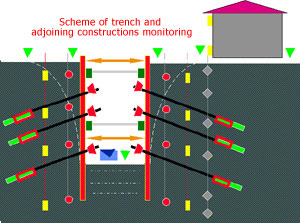
Monitoring
of engineering shield of the trench
Production stills of installation and application of technical monitoring equipment
|
|
|
|
|
|
|
|
|
|
During the works on increasing of bearing capacity of rocks and soils under the building, on underpinning ("Geocomposit", "Soil Jet-Grounting" methods; see more information at the web-sites: www.geomassiv.ru or www.jet-grouting.ru) at the first stage it is effectual to carry out the comprehensive survey of the entire volume of rock masses under the building. This allows to select weakened areas and purposefully attend to their reanimation. For a problem object there can be created a local monitoring system which allows to control efficiency of the works being conducted, behavior of the object (stability) after its reinforcement or to adjust (if necessary) the places of reimpact.

































